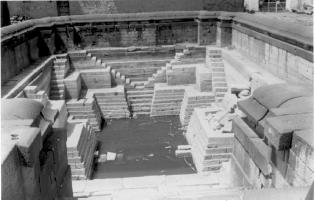/regions/bellary-district
Bellary District
80% of India's surface water is polluted
Posted on 29 Jun, 2015 08:55 PMDomestic sewerage responsible for 75-80% of water pollution in the country

Rs 2000 crore action plan to restore mining ravaged areas in Karnataka
Posted on 09 Feb, 2015 01:54 PMKarnataka sets up firm to mitigate mining impacts

Floods in Assam affect one lakh people - Dhemaji worst hit
Posted on 08 Jul, 2013 11:31 AMFlood fury hits Assam

Khazana Bawali - Historical wisdom needing protection - Paper presented at the National Seminar on Water and Culture (2007)
Posted on 14 Feb, 2011 03:57 AMThis paper presents the case of Khazana Bawali - a large ancient well that irrigated around 1000 acres in the past but is now in disrepair. The well is about 20 metres in diameter which stores rainwater from the neighbouring hills. The water is brought through underground tunnels that have ventilators at regular intervals to ensure fresh air and also to help in its manual cleaning. This well today irrigates only about 525 acres. It was built by the Jagirdar of Beed in 1582.
Water management in the Vijaynagar empire - Paper presented at the National Seminar on Water and Culture (2007)
Posted on 14 Feb, 2011 01:55 AMThis paper focuses on water management techniques used in two tanks constructed by the kings of the Vijaynagar Empire.
The first example taken, is that of the Anantraj Sagar built by the son of the minister of Harihar. The lake is still in use and there are inscriptions on stone near it which provide a thumb rule to constructing lakes. Construction of this lake began in 1369 and was completed in 2 years. The paper states that the length of the dam was 5000 dand, width was 8 dand and the height was 7 dand (One dand is about one metre).
Idol immersion activities and their management in water bodies in India - Paper presented at the National Seminar on Water and Culture (2007)
Posted on 13 Feb, 2011 11:07 PMThis paper begins with an analysis of the rationale for idol immersion in Hinduism. Some of the reasons given by the author include water being able to disintegrate idols, the idea of purity of water etc.
Glimpses of the historical water bodies in the Vijaynagar dynasty - Paper presented at the National Seminar on Water and Culture (2007)
Posted on 30 Jan, 2011 03:44 AMThis paper uses secondary data to showcase the water bodies that were built in the Vijayanagar Empire. The author states that there were 88 such water bodies and these were used for irrigation purposes and also for consumption.
Volunteering opportunity in a wetlands project near Hampi
Posted on 24 Jan, 2011 06:41 PMThis pond and wetland is the first stage of creating a wildlife field station and research center for WildlifeSOS in Ramdurga Valley.
The wetland will be both for habitat and as a safe water source for wildlife. Concurrent with the construction of the wetland will be the design process for the field station and site. Volunteers will assist in both these processes with the primary task of completing construction of the wetlands. Long afternoon breaks and evening's slow relaxation will be time for learning, discussions and wandering conversations. Areas of discussion may include: Permaculture basics (principles, flows, patterns, zonation), site analysis, water, soil, plants and cropping, animals systems, appropriate technology, invisible structures (economic, cultural and social systems), design and local to global sustainability.
Influence of Chalukya architecture on Hampi stepwell - Paper presented at the National Seminar on Water and Culture (2007)
Posted on 29 Dec, 2010 04:16 PM
This paper discusses the reasons for building tanks in ancient India and mentions ancient texts like 'Samarangan Sutradhar' to indicate how wells and other water bodies were constructed.
These water storage systems indicate the knowledge of geology, soil engineering, construction engineering and structural engineering in ancient times.
Total water management by industry - A case study of JSW Steel (Vijayanagar)
Posted on 17 Nov, 2009 04:43 PMThe various initiatives taken up include installing a fin-fan heat exchanger, rain water harvesting, increasing cycles of concentration in cooling towers, pumping seepage water, cascading use of water, zero waste water discharge and more.